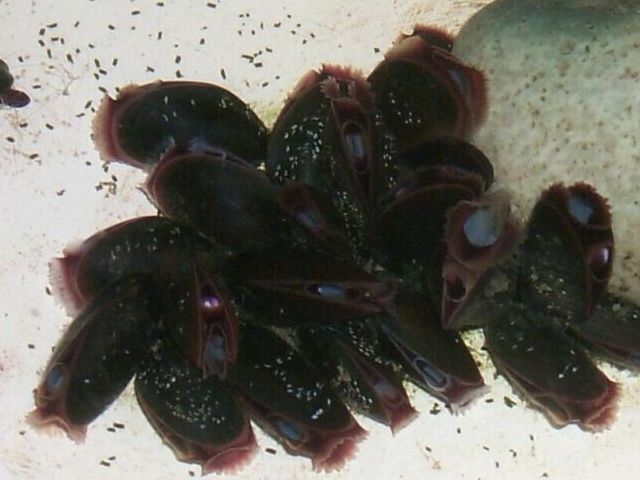Blue Mussel

Scientific Name: Mytilus edulis
Phylum: Mollusca
Class: Bivalvia
Description: Blue mussel has smooth external bivalve shell. They are ovoid in shape, bluish-black in colour, and have terminal beaks.
Distribution: Most commonly found in inter-tidal or shallow sub-tidal zones. Extends South in the western Atlantic Ocean to South Carolina .
Locomotion: Sessile – attach themselves with byssal threads to any firm support available.
Food gathering/digestion: Filter feeders – will ingest plankton and non-living organic matter. Water is driven from inhalant to exhalent parts of mantle cavity by cilia. Feeding material is sorted by size and rejected particles fall of gill edges into mantle cavity as pseudo-feces.
Gas Exchange: Mantle cavity allows ctenidia to develop a greatly enlarged surface area, which serves as both gas exchange and feeding.
Reproduction: Sexual – external fertilization happens from May to August in response to environmental triggers (increased temperature and food). Larvae hatch and are planktonic for the first 3-4 weeks then settle (spat) for a benthic existence. Once attached, they metamorphose into juveniles.
Interesting Facts: Mussels are preyed upon by sea ducks, starfish and crabs. Fouling by kelp and anemones causes suffocation by reducing water circulation through the mussel colony. When filter feeding, they can maintain pumping rates of about 1 liter/hour per gram of body weight. In NL, blue mussels are a major aquaculture industry. Wild spat is collected and placed in mussel socks.
Images
 |
OSC Research
Thompson Lab - Physiological genetics of the mussels Mytilus edulis and M. trossulus: R. Thompson, D. Innes (Biology).
The two species of mussels occur sympatrically in Newfoundland and produce hybrids. The viability of hybrids and the mechanisms by which the hybrid zone is maintained are being examined. Both pre- and post- zygotic mechanisms are being investigated. A combination of nuclear and allozyme markers is being used. At most sites M. trossulus dominates the larval and juvenile stages, while M. edulis is dominant in the adults. There is a partial separation in the timing of the reproductive cycles, permitting some interbreeding between the species and accounting partially for the presence of hybrids. Preliminary work suggests that there may be partial blocks to fertilisation between the species. Laboratory studies are in progress to compare fertilisation rates for F1 x F1 crosses and backcrosses from F1s to the each parent species, as well as the growth and survival rates of the resulting larvae and spat. This work is relevant to the mussel aquaculture industry in Atlantic Canada, because both species and their hybrids occur at mussel farms, and there is evidence that in some sites M. trossulus is a less desirable product than M. edulis.